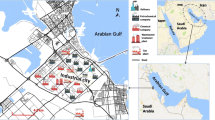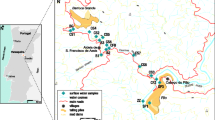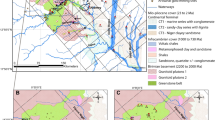Abstract
Purpose
Mining activities generate large amounts of wastes that may contain potentially toxic elements (PTE), which, if released into the environment, may cause air, water and soil pollution long after mining operations have ceased. This paper describes the environmental relevance of efflorescences, topsoils and surface waters from the abandoned mine of Sierra Minera of Cartagena-La Unión, SE Spain. The exposure of the population to arsenic and the associated risk were also assessed.
Materials and methods
A total of 10 topsoils and surface waters and 11 efflorescences affected at varying degrees by mining activities were studied. The total potentially toxic element content (As, Cd, Cu, Fe, Pb and Zn) was determined in all samples. In addition, the mineralogical composition of solid samples was determined by X-ray diffraction and some efflorescences were also analysed using a scanning electron microscopy-energy dispersive X-ray spectrometer. Finally, an arsenic-intake risk assessment was carried out, both as regards carcinogenic and non-carcinogenic effects and considering the total and the bioaccesible As content.
Results and discussion
The study area is heavily polluted as a result of historical mining and processing activities, during which time great amounts of wastes were produced, characterised by a high PTE content, acidic pH and minerals resulting from supergene alteration. The supergene mineralogical assemblages include soluble metal salts, mainly sulphates, iron hydroxysulphates and iron oxyhydroxides, all of which form ochreous precipitates. Topsoil samples showed risk values and hazard quotients higher than the reference levels, particularly for children. In the efflorescences, these values were lower but still unacceptable.
Conclusions
The efflorescences are of significance for monitoring purposes because they are involved in cycles of retention release of hydrogen ions, sulphate and potentially toxic elements. In addition, in a semi-arid climate, such as the study area, these minerals contribute to our understanding of the response of the system to episodic rainfall events. In general, it was observed that the arsenic in collected samples represent a potential risk for human health through ingestion.








Similar content being viewed by others
References
Basta NT, Rodriguez RR, Casteel SW (2001) Bioavailability and risk of arsenic exposure by the soil ingestion pathway. In: Frankenberger WT (ed) Environmental chemistry of arsenic. Marcel Dekker, New York, p 117
Buckby T, Black S, Coleman ML, Hodson ME (2003) Fe-sulphate-rich evaporative mineral precipitates from the Rio Tinto, southwest Spain. Mineral Mag 67:263–278
Carbone C, Dinelli E, Marescotti P, Gasparotto G, Lucchetti G (2013) The role of AMD secondary minerals in controlling environmental pollution: Indications from bulk leaching tests. J Geochem Explor 132:188–200
Castillo S, de la Rosa J, Sánchez de la Campa JD, González-Castanedo Y, Fernández-Caliani JC, González I, Romero A (2013) Contribution of mine wastes to atmospheric metal deposition in the surrounding area of an abandoned heavily polluted mining district (Rio Tinto mines, Spain). Sci Total Environ 449:363–372
Conesa HM, Schulina R, Nowasck B (2008) Mining landscape: a cultural tourist opportunity or an environmental problem? The study case of the Cartagena–La Unión Mining District (SE Spain). Ecol Econ 64:690–700
Dold B, Fontboté L (2001) Element cycling and secondary mineralogy in porphyry copper tailings as a function of climate, primary mineralogy and mineral processing. J Geochem Explor 74:3–55
FAO-UNESCO (1990) Soil map of the world—revised legend. FAO, Rome
Fernández-Ortiz de Vallejuelo S, Gredilla A, de Diego A, Arana G, Madariaga JM (2014) Methodology to assess the mobility of trace elements between water and contaminated estuarine sediments as a function of the site physico-chemical characteristics. Sci Total Environ 473–474:359–371
García-Lorenzo ML, Martínez-Sánchez MJ, Pérez-Sirvent C (2014a) Application of a plant bioassay for the evaluation of ecotoxicological risks of heavy metals in sediments affected by mining activities. J Soils Sediments 14:1753–1765
García-Lorenzo ML, Martínez-Sánchez MJ, Pérez-Sirvent C, Agudo I, Recio C (2014b) Isotope geochemistry of waters affected by mining activities in Sierra Minera and Portman bay (SE, Spain). Appl Geochem 51:139–147
García-Lorenzo ML, Pérez-Sirvent C, Molina-Ruiz J, Martínez-Sánchez MJ (2014c) Mobility indices for the assessment of metal contamination in soils affected by old mining activities. J Geochem Explor 147(Part B):117–129
García-Rizo C, Martínez-Sánchez MJ, Pérez-Sirvent C (1999) Environmental transfer of zinc in calcareous soils in zones near old mining sites with semi-aridic climate. Chemosphere 39(2):209–227
González-Ciudad E (2014) Evaluación en nave cerrada de los riesgos para la salud en tecnosoles procedentes de residuos de minería polimetálica. Doctoral thesis, University of Murcia
Hammarstrom JM, Seal RR II, Meier AL, Kornfeld JM (2005) Secondary sulphate minerals associated with acid drainage in the eastern US: recycling of metals and acidity in surficial environments. Chem Geol 215:407–431
Harris DL, Lottermoser BG, Duchesne J (2003) Ephemeral acid mine drainage at the Montalbion silver mine, North Queensland. Aust J Earth Sci 50:797–809
Kelley ME, Brauning SE, Schoof RA, Ruby MV (2002) Assessing oral bioavailability of metals in soil. Battelle, Columbia
López-García JA, Lunar R, Oyarzun R (1988) Silver and lead mineralogy in Gossan-type deposits of Sierra de Cartagena, southeast Spain. Trans Inst Min Metall, Sect B 97:82–88
Lottermoser B (2007) Mine wastes- characterization, treatment and environmental impacts. Springer, Berlin
Manteca JI, Ovejero G (1992) Los yacimientos Zn, Pb, Ag-Fe del distrito minero de La Unión-Cartagena, Bética Oriental. CSIC Textos Universitarios 15:1085–1110
Martínez-Sánchez MJ, Pérez-Sirvent C (2013) Diagnóstico y Recuperación de la Contaminación del Suelo en Portmán-Sierra Minera. In: Baños González I, Baños Paéz P (eds) Portmán: de el “Portus Magnus” del Mediterráneo Occidental a la Bahía Aterrada. Editum, Murcia, pp 313–344
Martínez-Sánchez MJ, Navarro MC, Pérez-Sirvent C, Marimón J, Vidal J, García-Lorenzo ML, Bech J (2008) Assessment of the mobility of metals in a mining-impacted coastal area (Spain, Western Mediterranean). J Geochem Explor 86:171–182
Martínez-Sánchez MJ, Martínez-López S, Martínez-Martínez LB, Pérez-Sirvent C (2013) Importance of the oral arsenic bioaccessibility factor for characterising the risk associated with soil ingestion in a mining-influenced zone. J Environ Manag 116:10–17
Martínez-Sánchez MJ, García-Lorenzo ML, Pérez-Sirvent C, González E, Pérez V, Martínez S, Martínez L, Molina J (2014) Heavy metal immobilisation by limestone filler in soils contaminated by mining activities: effects on metal leaching and ecotoxicity. Int J Min Reclam Environ 28(6):414–425
Matusiewicz H (2003) Wet digestion methods. In: Mester Z, Sturgeon R (eds) Sample preparation for trace element analysis. Elsevier, Amsterdam, pp 195–235
Meunier L, Koch I, Reimer KJ (2011) Effect of particle size on arsenic bioaccessibility in gold mine tailings of Nova Scotia. Sci Total Environ 409:2233–2243
Navarro MC, Pérez-Sirvent C, Martínez-Sánchez MJ, Vidal J, Marimón J (2006) Lead, cadmium and arsenic bioavailability in the abandoned mine site of Cabezo Rajao (Murcia, SE Spain). Chemosphere 63:484–489
Navarro-Hervás MC, Pérez-Sirvent C, Martínez-Sánchez MJ, García-Lorenzo ML, Molina J (2012) Weathering processes in waste materials from a mining area in a semiarid zone. Appl Geochem 27:1991–2000
Nordstrom DK (2011) Hydrogeochemical processes governing the origin, transport and fate of major and trace elements from mine wastes and mineralized rock to surface waters. Appl Geochem 26:1777–1791
Oen IS, Fernandez JC, Manteca JI (1975) The lead-zinc and associated ores of La Union, Sierra de Cartagena, Spain. Econ Geol 70:1259–1278
Ovejero G, Jacquin JP, Servajean G (1976) Les minéralisations et leur contexte géologique dans la Sierra de Cartagena (sud-est de léspagne). Bull Soc Geol Fr 7:619–633
Peña JA, Manteca JI, Martínez-Pagán P, Teixidó T (2013) Magnetic gradient map of the mine tailings in Portman Bay (Murcia, Spain) and its contribution to the understanding of the bay infilling process. J Appl Geophys 95:115–120
Peña-Fernández A, González-Muñoz MJ, Lobo-Bedmar MC (2014) Establishing the importance of human health risk assessment for metals and metalloids in urban environments. Environ Int 72:176–185
Pérez-Sirvent C, Martínez-Sánchez J, García-Rizo C (1998) Lead mobilization in calcareous agricultural soils. In: Iskandar IK, Magdi Selim H (eds) Fate and transport of heavy metals in the vadose zone. CRC Press, Boca Raton, pp 177–199
Pérez-Sirvent C, Martínez-Sánchez MJ, Martínez-López S, Bech J, Bolan N (2012) Distribution and bioaccumulation of arsenic and antimony in Dittrichia viscose growing in mining-affected semiarid soils in southeast Spain. J Geochem Explor 123:128–135
Pérez-Sirvent C, Martínez-Sánchez MJ, García-Lorenzo ML, Hernández-Córdoba M, Molina J, Martínez S, González E, Pérez-Espinosa V (2014) A preliminary zonation to support the remediation and the risk assessment of an area contaminated by potential toxic elements in Murcia Region (SE, Spain). Procedia Earth Plan Sci 10:388–391
Robles-Arenas VM, Candela L (2010) Hydrological conceptual model characterisation of an abandoned mine site in semiarid climate. The Sierra de Cartagena-La Unión (SE Spain). Geol Acta 8(3):235–248
Robles-Arenas VM, Rodríguez R, García C, Manteca JI, Candela L (2006) Sulphide-mining impacts in the physical environment: Sierra de Cartagena–La Unión (SE Spain) case study. Environ Geol 51:47–64
Ruby MV, Schoof R, Brattin W, Goldade M, Post G, Harnois M, Mosby DE, Casteel SW, Berti W, Carpenter M, Edwards D, Cragin D, Chappell W (1999) Advances in evaluating the oral bioavailability of inorganics in soil for use in human health risk assessment. Environ Sci Technol 33:3697–3705
Sainz de Baranda B, González de Tánago J, Viñals J (2003) Secondary minerals of the Mazarrón-Águilas mining district, Murcia province, Spain. Mineral Rec 34:315–334
Simate GS, Ndlovu S (2014) Acid mine drainage: challenges and opportunities. J Environ Chem Eng 2:1785–1803
Smith RL (1996) Risk-based concentrations: prioritising environmental problems using limited data. Toxicology 106:243–266
US EPA (1989) Risk assessment guidance for superfund. Volume 1: human health evaluation manual (part A). Office of Emergency and Remedial Response
US EPA (1998) Risk assessment guidance for superfund volume 1: human health evaluation manual (Part D)
Valente TM, Leal Gomes CL (2009) Occurrence, properties and pollution potential of environmental minerals in acid mine drainage. Sci Total Environ 407:1135–1152
Valente T, Antunes M, Braga MA, Pamplona J (2011) Geochemistry and mineralogy of ochre-precipitates formed as waste products of passive mine water treatment. Geochem Explor Environ Anal 11:103–106
Valente TM, Grande JA, de la Torre ML, Santiesteban M, Cerón JC (2013) Mineralogy and environmental relevance of AMD-precipitates from the Tharsis mines, Iberian Pyrite Belt (SW, Spain). Appl Geochem 39:11–25
Author information
Authors and Affiliations
Corresponding author
Additional information
Responsible editor: Claudio Bini
Rights and permissions
About this article
Cite this article
Pérez-Sirvent, C., Hernández-Pérez, C., Martínez-Sánchez, M.J. et al. Geochemical characterisation of surface waters, topsoils and efflorescences in a historic metal-mining area in Spain. J Soils Sediments 16, 1238–1252 (2016). https://doi.org/10.1007/s11368-015-1141-3
Received:
Accepted:
Published:
Issue Date:
DOI: https://doi.org/10.1007/s11368-015-1141-3




